Series
Geology and Wine 13.
Geographic Information System Characterization of Four Appellations in West Texas, USA
SUMMARY
Texas produces approximately 90 000 hl of wine annually from more than 200 wineries and 1214 ha of vineyards. Eight wine grape production regions are officially recognized as American Viticultural Areas (AVAs) in Texas. Improved understanding of the growing conditions within each AVA facilitates selection of well-adapted cultivars that is critical for continued success and expansion of the wine industry. A geographic information system (GIS) was developed to enable enhanced characterization of the climatic, geologic and edaphic conditions of Texas AVAs. The GIS contains datasets describing climatic variables, geology, soils, elevation and topography, all of significance to grape production. This paper characterizes the four viticultural areas (AVAs) of west Texas: Texas High Plains AVA, Escondido Valley AVA, Texas Davis Mountains AVA, and Mesilla Valley AVA. Common features of the four AVAs are relatively high elevation, warm to very warm growing-season temperatures, mild winter temperatures, and low annual precipitation. Local differences in elevation and topography modify climatic conditions among AVAs, providing variations in growing degree-days and ripening-period mean temperatures that influence the performance of grape cultivars. The Texas High Plains and Texas Davis Mountains AVAs have the lowest growing degree-days and coolest ripening-period mean temperatures; Escondido Valley and Mesilla Valley AVAs are drier and warmer, resulting in fruit ripening earlier than in the High Plains and Davis Mountains AVAs. Variable underlying geology leads to differing soil types planted to vineyards in each AVA; predominantly loamy fine sands and fine sandy loam in Texas High Plains, silty clay loam and loam in Escondido Valley, loam and clay loam in Texas Davis Mountains, and clay loam and sandy loam in Mesilla Valley. West Texas produces red wines from Cabernet Sauvignon and Merlot cultivars, which are notable for good tannin and excellent colour; recent planting trends to warm-climate cultivars, including Tempranillo, Sangiovese, Mourvèdre, and Grenache, are producing blended wines of great promise. Similarly, a solid reputation for white wines from Chenin blanc and Chardonnay is being enhanced by increased production of Viognier, Vermentino, and other warm-climate varietal wines.
SOMMAIRE
Texas produit environ 90 000 hectolitres de vin par année provenant de plus de 200 établissements vinicoles et 1214 ha de vignes. Huit régions de productions de raisins de cuve sont officiellement reconnues comme zones viticoles américaines (AVA) en Texas. Une meilleure compréhension des conditions de croissance au sein de chacune AVA facilite le choix des variétés, (cultivars) adaptées pour le succès et l’expansion continue de l’industrie viticole. Un système d’information géographique (SIG) a été développé pour permettre la caractérisation améliorée des conditions climatiques, géologiques et édaphiques de l’AVA de Texas. Le SIG contient les ensembles de données décrivant les variables climatiques, la géologie, les sols, l’altitude, et topographie d’importances pour la production viticole. Ce document caractérise les quatre Zones viticoles de l’Ouest Texas: Texas High Plains, Escondido Valley, Texas Davis Mountains, et Mesilla Valley. Les caractéristiques communes entre des quatre AVA sont relativement haute altitude, très chaudes températures de saison de croissance, les températures de l’hiver doux et faibles précipitations annuelles. Les variations locales en altitude et topographie modifient les conditions climatiques entre les zones viticoles américaines et entraînent des variations des degrés-jour de croissance (GDD) et la température moyenne de mûrissement (RPMT), ce qui exercent une influence sur rendement des cultivars de raisin. Le Texas High Plains et le Texas Davis Mountains zones viticoles ont les GDD les plus bas et une RPMT froide; le Escondido Valley et Mesilla Valley zones viticoles sont plus secs et plus chauds, ce qui entraine le mûrissement de fruit plus tôt que dans le High Plains et Davis Mountains AVAs. Variable géologie sous-jacente conduit à une variation des types de sol plantés aux vignobles dans chaque AVA ; principalement loam sableux et le loam sablo-argileux dans Texas High Plains, loam limoneux et loam dans Escondido Valley, loam et loam argileux dans Texas Davis Mountains, et loam argileux et loam sableux dans Mesilla Valley. Ouest Texas produit des vins rouges de Cabernet Sauvignon et le Merlot qui se distinguent par le tanin et une couleur excellente, les tendances récentes à la plantation de climat chaud cultivars, y compris le Tempranillo, le Sangiovese, Mourvèdre, et Grenache, produisent des vins d’assemblages de grandes promesses. De même, une solide réputation pour les vins blancs de Chenin blanc et le Chardonnay est améliorer par l’augmentation de la production de Viognier, Vermentino, et d’autres vins de climat chaud cépages.
INTRODUCTION
1 The American southwest, including parts of west Texas, represents the earliest successful viticulture and oldest continuous tradition of winemaking in North America (Pinney 1989). Sacramental wine was necessary for missionaries to conduct religious services, and the remoteness of the unsettled southwest required local wine production. Accordingly, Spanish missionaries in the seventeenth century brought Vitis vinifera grapevines to plant at missions they established in the region. In 1681, Franciscans established a mission at Ysleta on the Rio Grande near El Paso (Kingston 1988), within the present-day Mesilla Valley winegrowing appellation.
2 Over the next 200 years, wine-growing in the El Paso area (Fig. 1) expanded beyond the missions, becoming the most important revenue-producing crop in the region by the early part of the nineteenth century (Pinney 1989). During this period, El Paso held a favourable reputation among traders for ‘Pass Wine’ as well as the local brandy. Grape cultivation nearly vanished from the area in the early twentieth century owing to a period of extensive flooding along the Rio Grande and the passage of prohibition in Texas in 1919. Renewed interest in winegrowing led to the creation, in 1985, of the Mesilla Valley American Viticultural Area, which lies within El Paso County, Texas and Doña Ana County, New Mexico.
3 Today, the broad region of west Texas is a major contributor to the Texas wine industry, which produces approximately 90 000 hl annually (MKF Research 2008) from more than 200 wineries. Vineyards in west Texas account for 66% of the approximately 1214 ha of vineyards in the state (National Agricultural Statistics Service 2009) and the state’s two largest wineries are located in this region. There are four American Viticultural Areas in west Texas: Texas High Plains, Escon-dido Valley, Texas Davis Mountains, and Mesilla Valley.
 Display large image of Figure 1
Display large image of Figure 14 An American Viticultural Area (AVA) is strictly geographically focused compared to European wine appellations, which often prescribe grape cultivars and production practices; it is an officially recognized "delimited grape growing region distinguishable by geographical features, the boundaries of which have been recognized and defined" through a petition process (Code of Federal Regulations (CFR) Title 27, Part 4, Subpart C, Section 4.25). An AVA designation is one type of appellation permitted on American wine labels to provide consumers with information on the growing locale of grapes used in the labelled wine. Petitions for new viti-cultural areas are considered for approval by the Alcohol and Tobacco Tax and Trade Bureau, provided there is evidence that the proposed name of the viticultural area is locally or nationally known as referring to the area specified; the boundaries are as specified; and the geographical features (climate, soil, elevation, physical features, etc.) distinguish the viticultural features of the proposed area from surrounding areas (CFR Title 27, Part 9, Subpart A).
5 American wine may be labelled with an approved AVA appellation, if no less than 85% of the wine is derived from grapes grown within the AVA and the wine has been fully finished in the State, within which the labelled AVA is located. Vintage-labelled American wine that also displays the AVA must be at least 95% derived from grapes harvested in the labelled year. The term ‘estate bottled’ may be used on a wine label only if the wine is labelled with an AVA appellation of origin and the bottling winery is i) located in the labelled AVA; ii) grew all of the grapes used to make the wine on land owned or controlled by the winery within the boundaries of the AVA; and iii) crushed the grapes, fermented the resulting must, and finished, aged, and bottled the wine in a continuous process.
6 The official description of AVAs published within the CFR Title 27, Part 9, Subpart A, details only the AVA boundaries; it does not provide the descriptions of climate and soils from the original petitions, which moreover are often limited in detail. Therefore, a geographic information system (GIS) was developed to characterize the climatic, geologic and edaphic (soil) conditions of Texas AVAs. GIS is a powerful tool for the spatial analysis of environmental factors at the landscape level, and has been previously applied to the analysis of the viticultural potential of the Umpqua Valley (Jones et al. 2004) and the Rogue Valley (Jones et al. 2006) AVAs in Oregon, and to assess viticultural performance in the Okanagan and Similkameen valleys in British Columbia (Bowen et al. 2005). The Texas AVA project developed and utilized a GIS to characterize the eight AVAs in the State, and produced an interactive website, the Winegrowing Regions of Texas, for public access to the system [txwineregions.tamu.edu].
COMPONENTS OF GIS
7 The Texas AVA GIS (AVATXIS) was developed by the authors; construction of the system is described in detail elsewhere (Takow 2008). The GIS layers, data sources, and their relevance to grape production are summarized below.
8 Elevation and topography often have an important influence on grape production, albeit indirectly through effects on temperature and solar radiation (Jones and Hellman 2003). Absolute elevation above sea level determines temperature, and relative elevation of a site compared to surrounding topography influences cold air drainage and temperature variations along a slope. The slope and aspect of a site affect sunlight reception and air drainage. Elevation data were obtained from the National Elevation Dataset [seamless.usgs.gov], a seamless mosaic of the highest-resolution, best quality elevation data available across the United States (United States Geological Survey 2002). Topo-graphic categorization of the Texas AVAs was carried out using 10 m digital elevation models (DEM) to determine areas of higher elevation and to calculate hill shade values.
9 Gladstones (1992) detailed the aspects of climate critical to grape production in his authoritative book Viti-culture and Environment, in which he emphasized the great influence of temperature on grape and wine production as well as the effects of sunlight, rainfall, and relative humidity. A common measure of biologically effective temperatures for grapes is the heat summation index known as growing degree-days (GDD). This index was utilized in California to help categorize regions of the state as a guide to suitability of grape varieties (Winkler et al. 1974). Although it has limitations, use of GDD has subsequently become a rough guide for global comparisons of growing season temperatures among viticultural regions, and for selection of climate-appropriate grape varieties. The average climatic conditions of a given region are considered to be the major determinants of the grape varieties and styles of wine produced therein (Jones and Hellman 2003).
10 Climatic data were obtained from Daymet [daymet.org], a climatic database produced from a model that generates daily surfaces of temperature, precipitation, humidity, and radiation over large regions of the United States (Thornton et al. 1997). The model utilizes digital elevation models and daily observations from an 18-year daily dataset (1980–1997) to produce climatic variables. This daily dataset of temperature, precipitation, humidity and radiation has been prepared as a continuous surface at 1 km resolution. Climatic variables used in the characterization of Texas AVAs were: daily maximum temperature, daily minimum temperature, daily average temperature, and annual precipitation. GDD was determined by the standard method developed in California (Winkler et al. 1974); 10°C was subtracted from the mean daily temperature and the cumulative sum through the growing season (April 1st through October 31st) calculated. Ripening-period mean temperature (RPMT) was calculated for the months in which grapes typically ripen.
11 The underlying geology of a region influences vineyards through the physical and chemical characteristics of surface soils evolved from weathering of parent rock (Wilson 1998; Macqueen and Meinert 2006). Climate and geology interact in soil-forming processes, and geology also determines the topography and land-forms of a region. Geologic data were obtained from the digital geologic map database of Texas, which was derived from the 1992 Geologic Map of Texas (Stoeser et al. 2005). The United States Geological Survey obtained original clear film positives of the Geologic Map of Texas and photographically enlarged them onto Mylar film. These films were scanned, geo-referenced, digitized, attributed, edge-matched, and combined into a single statewide database.
12 Worldwide, wine grapes are successfully grown on a wide range of soils; there is no single soil type that is ideal for grape production. Soil characteristics define the baseline of water and nutrient availability, which together apply the greatest initial influence on grapevine vigour (Jones and Hellman 2003). The generally accepted criteria for vineyard suitability were summarized by Nicholas (2004): soil depth of at least 60 to 100 cm, good internal drainage, adequate water infiltration rate, good water holding capacity, pH between 5.0 and 8.5 in the root zone, and the absence of toxic concentrations of salts or mineral nutrients such as boron, aluminum or manganese.
13 The source of soils data was the State Soil Geographic (STATSGO) database, which consists of geo-referenced map data and associated tables of attribute data (Soil Conservation Service 1994). Map units in STATSGO are a combination of geographically associated phases of soil series. The attribute database gives the proportionate extent of the component soils and the soil properties. The characterization of Texas AVAs utilized the following soil properties: texture, depth, available water capacity, soil pH, and permeability. Permeability (saturated hydraulic conductivity) is a measure of the ease of water movement in soil. Soils with permeability within the range of 3.6 to 36 cm/hr are most favourable for grape production.
CHARACTERIZATION OF WINE-GROWING REGIONS
14 The State of Texas has an area of 69 561 900 ha, within which a broad diversity of geology, soils, climate, and ecosystems exists (Alvarez 2008). Elevation ranges from sea level at the Gulf of Mexico to over 2400 m in the Guadalupe Mountains of far west Texas. Climate varies from semitropical to continental. This diversity is categorized into seven physiographic provinces: Gulf Coastal Plains, Grand Prairie, Edwards Plateau, Central Texas Uplift, North-Central Plains, High Plains, and Basin and Range (Wermund 2008). There are four AVAs in west Texas (Fig. 1); Texas High Plains AVA is located in the High Plains physio-graphic province, Escondido Valley AVA lies within the Edwards Plateau, and the Texas Davis Mountains AVA and the Mesilla Valley AVA are found within the Basin and Range physiographic province.
Texas High Plains
15 Texas High Plains AVA (Fig. 1) was established in 1993 to recognize the unique viticultural characteristics of this high-elevation plateau composed of deep alluvial materials. It is the second largest AVA in Texas, containing nearly 3.6 million ha in the western part of the state, mostly south of the Panhandle region (Table 1). As the name indicates, this AVA lies within the High Plains sub-region (also known as the Llano Estacado), which is part of the southernmost extension of the vast Great Plains physiographic province of the central United States. The western boundary of the Texas High Plains AVA is the Texas–New Mexico border, where elevation reaches its highest point at about 1250 m in the northwestern part of the AVA. The plateau slopes gently down to the southeast where the eastern border of the AVA follows the 914 m elevation contour along the Caprock Escarpment, the steep transitional zone separating the High Plains from the lower Rolling Plains sub-region to the east.
 Display large image of Table 1
Display large image of Table 116 Grapes and wine have been produced in this region since the mid-1970s, and vineyards here have become a major grape supplier to wineries throughout Texas. At present, there are just over 440 hectares of vineyards within the AVA, although expansion continues in an effort to supply the rapid growth of the Texas wine industry. Prominent grape cultivars in the region are Cabernet Sauvignon, Chardonnay, and Merlot (National Agricultural Statistics Service 2009) as well as Muscat blanc. Recent plantings demonstrate increased interest in Tempranillo, Viognier, Mourvèdre, Grenache, Vermentino, and other cultivars anticipated to have good adaptation to the region.
Climate
17 The climate of the Texas High Plains AVA is semi-arid, with hot summers and mild winters. Temperatures generally decrease with increasing elevation from southeast to northwest (Fig. 2a). Most of the region receives an average annual precipitation of 43.7 to 52.6 cm; the range throughout the AVA is 41.4 to 63.7 cm, increasing from west to east (Table 1; Fig. 2b). Cumulative GDD (Fig. 2c) follows the pattern of elevation: the lowest GDD is in the northwestern corner of the AVA, averaging 2028, and the highest in the southeastern region, at 2653. For comparison, the low range of degree-days is comparable to the Sierra Foothills region of California and the high range to Fresno, California (Table 2). It is noteworthy that the broad range of degree-days within the Texas High Plains AVA overlaps with the degree-days range of many well-established wine regions in California, including Napa Valley, Lodi, Paso Robles, and Temecula Valley (Jones et al. 2010). Grape RPMT ranges from 23.8 to 26.7°C in August and 19.9 to 22.6°C in September (Table 1; Fig. 2d). Night time minimum temperatures range from 16.7 to 19.4°C in August and from 12.2 to 15.6°C in September. Average daily temperature in January, the coldest month, ranges from 2.1 to 5.4°C, and minimum temperatures are -5.6 to -2.2°C. Freeze injury to grapevines occurs sporadically, usually in association with a rapid drop in temperature while vines are in early stages of cold acclimation in late autumn or de-acclimation in late winter. The region experiences 1 to 6 days of frost in April, presenting a risk of frost damage, particularly to grape cultivars with early budburst.
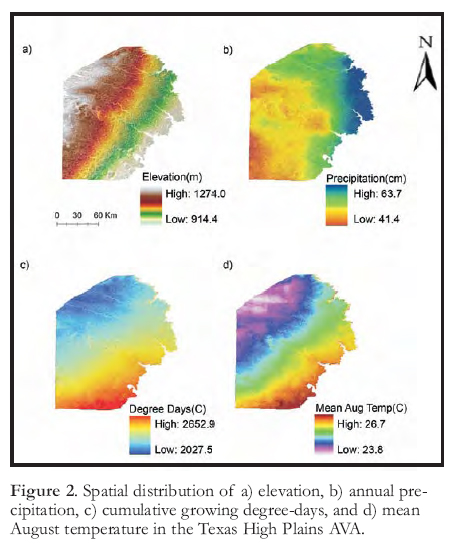 Display large image of Figure 2
Display large image of Figure 2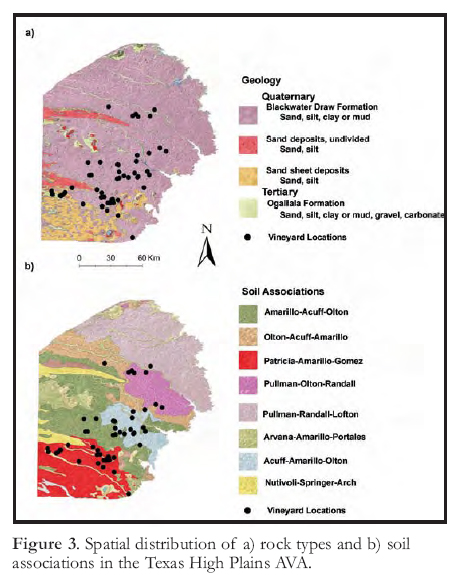 Display large image of Figure 3
Display large image of Figure 3Geology
18 The Texas High Plains AVA is underlain by the Blackwater Draw Formation (Fig. 3a), a sheet of Quaternary eolian sediment that is up to 27 m thick (Holliday 1989). These sediments vary in texture from sandy in the southwest to silty and clayey in the northeast; the textural fining is apparently the result of downwind sorting. The formation comprises up to six well-developed buried soils, indicating episodic sedimentation, that are similar to the regional surface soils. There are two narrow west–east trending fields of eolian sand dunes overlying the formation, and much of the southern region of the AVA is generally overlaid with upper Quaternary sand sheet deposits (Holliday 2001). The Ogallala Formation, of Miocene to Pliocene age, underlies the Blackwater Draw Formation and consists of sediments (sand, silt, clay, gravel, carbonate) derived from eolian and fluvial deposits. This formation is host to the important Ogallala Aquifer, the primary source for agricultural irrigation and drinking water in the region.
Soils
19 The region is characterized by very deep (>152 cm), well-developed soils with accumulations of calcium carbonate in the subsoil and clay increasing with depth. Distribution of general soil types in the region corresponds closely to geology, with texture becoming increasing finer from southwest to northeast (Fig. 3b). The Texas High Plains AVA contains 31 soil associations, five of which constitute 75% of the area: Pullman–Randall–Lofton 22.8%, Amarillo–Acuff–Olton 19.5%, Patricia–Amarillo–Gomez 15.5%, Olton–Acuff–Amarillo 9.5%, and Pullman–Olton–Randall 7.7% (Table 3). Pullman–Randall–Lofton soils have clayey subsoil horizons with shrink-swell potential and are not commonly planted to grapes (Fig. 3b).
20 The Amarillo–Acuff–Olton soil association covers almost 700 000 ha (Table 3), primarily in the west-central part of the AVA (Fig. 3b). It comprises deep soils with sandy loam texture from 0 to 30 cm depth, transitioning into sandy clay loam from 30 to 200 cm. Permeability of the upper 30 cm averages about 8.5 cm/hr; within the underlying sandy clay loam it is approximately 3.2 cm/hr. Soil pH increases with depth, from approximately 7.3 in sandy loam to 7.9 to 8.1 in sandy clay loam. Available water capacity ranges from 15 to 28 cm, increasing with depth (Table 3).
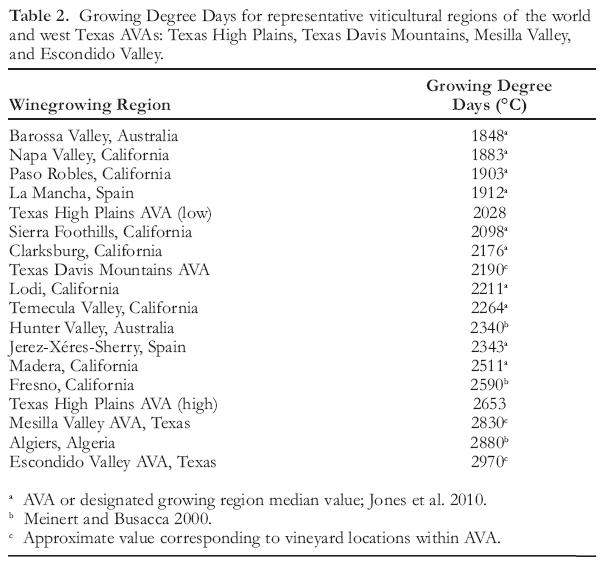 Display large image of Table 2
Display large image of Table 2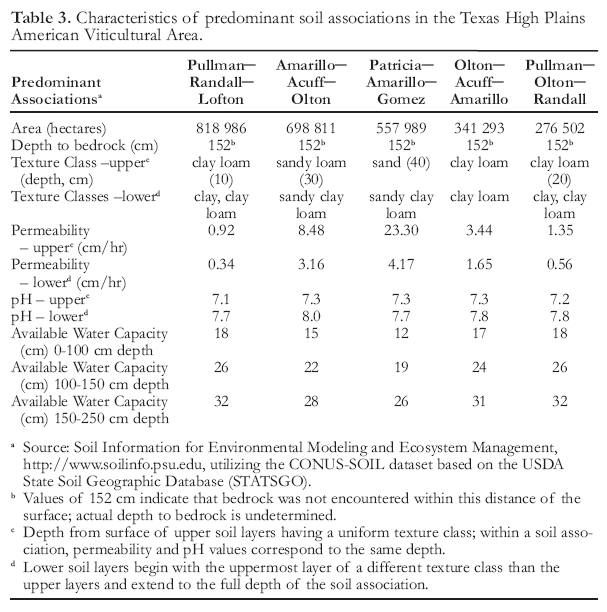 Display large image of Table 3
Display large image of Table 321 The Patricia–Amarillo–Gomez soil association predominates in the southern part of the AVA (Fig. 3b). These soils have a sand texture from 0 to 40 cm depth and sandy clay loam from 40 to 200 cm (Table 3). Permeability within the sand is high (21 to 24 cm/hr), decreasing to 3.5 to 6.5 cm/hr in the sandy clay loam. The pH ranges from 7.2 to 7.8, and available water capacity ranges from 12 to 26 cm, both increasing with depth.
22 Vineyards in the Texas High Plains AVA are predominantly planted on deep, reddish-brown Patricia and Amarillo loamy fine sands (205.9 ha) and Amarillo fine sandy loam (115.3 ha) soils (Fig. 4). The Amarillo and Patricia series are classified taxonomically as fine-loamy, mixed, superactive, thermic Aridic Paleustolls, and are favoured for their depth and combination of good internal drainage and subsoil with enough clay for adequate water-holding capacity (Table 4). Both soils are characterized by a friable calcareous zone in the subsoil; depth to this zone for Patricia soils is typically 152 to 203 cm (Natural Resources Conservation Service 1999), whereas in Amarillo soils it is 76 to 150 cm (Natural Resources Conservation Service 2010). Figure 5 illustrates a typical soil profile of an Amarillo fine sandy loam having an apparent calcareous zone at 100 to 140 cm depth. Favourable soil-water characteristics, low annual rainfall (see above), and low to moderate fertility of these soils enables viticulturists to manage grapevine vigour through irrigation practices, which is an important tool in optimizing canopy micro-climate for fruit quality.
Grape and Wine Production
23 The Texas High Plains AVA is home to approximately 60 vineyards totalling 440 ha, and six wineries, including the second-largest producer in the state, the Llano Estacado Winery. Vineyards tend to be relatively large (>9 ha), mechanized (Fig. 6), and not associated with a winery; grapes are sold to wineries both within and external to the Texas High Plains AVA. The region first established its winegrowing reputation with Cabernet Sauvignon and Merlot, frequently producing medal-winning wines that were commonly vineyard-designated on the label in recognition of local terroir. Recent planting trends have increased production of grape cultivars common to warm and hot climates, including Sangiovese, Vermentino and Tempranillo, and the Rhone cultivars Viognier, Grenache, Mourvèdre, and Syrah. The high quality of varietal wines or Rhone-type blends of these cultivars suggests that the region may be better suited to such warm-climate cultivars.
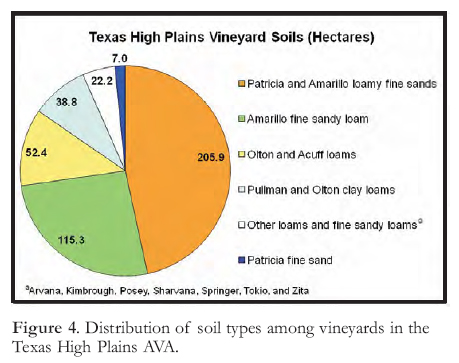 Display large image of Figure 4
Display large image of Figure 4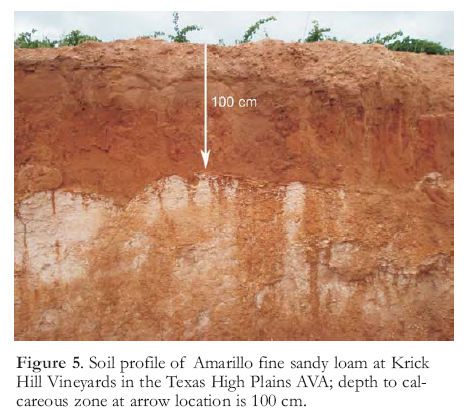 Display large image of Figure 5
Display large image of Figure 524 Climatic and edaphic conditions of the Texas High Plains AVA are conducive to high-quality grape production; although the region is considered to have a hot climate based on GDD, temperatures become favourably moderate at night during the fruit ripening period because of the high elevation and low relative humidity. Good tannin and colour development is characteristic of fruit from the region and vine fruitfulness is high, which are attributable to abundant sunlight and possibly an enhanced ratio of red to far red light wavelengths reflected from red soils (Gladstones 1992). Relatively low annual precipitation enables grapevine vigour management through irrigation practices. Low rainfall and low relative humidity also provide an environment conducive to few fungal diseases of grapes.
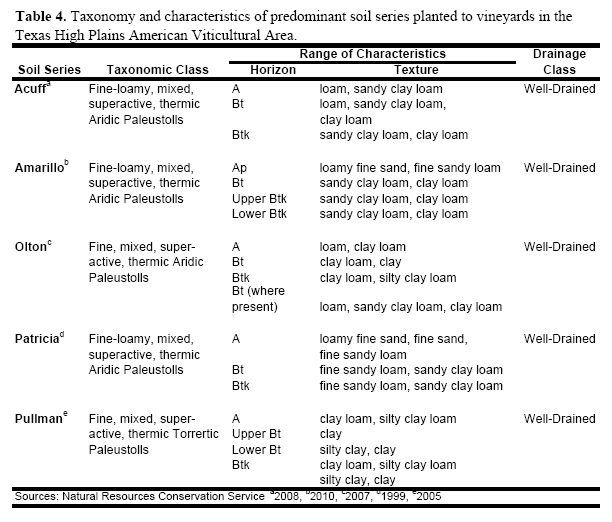 Display large image of Table 4
Display large image of Table 4Escondido Valley
25 The Escondido Valley viticultural area, located in Pecos County, Texas (Fig. 1), was established in 1992. This AVA covers approximately 12 600 ha at the northern edge of the Stockton Plateau, a western sub-region of the Edwards Plateau physiographic province immediately south of the High Plains. The southern boundary of the AVA is defined by the 914 m elevation contour line, and Interstate Highway 10 is the northern limit. The Escondido Valley AVA is a mesa-like plateau having more topographical variation than the Texas High Plains AVA, although much of the area is 300 m lower in elevation. The landscape is distinguished by higher elevations in the south and generally lower elevation in the north and northeast, ranging from 772 to 976 m, with an isolated peak at about 890 m in the far northeast end of the region. Grape cultivation began in the 1980s and the AVA was created to identify Texas’ largest estate vineyard (Mesa Vineyards; Fig. 7) and Ste. Genevieve winery. Approximately 288 ha of wine grapes are in production; predominant cultivars are Chenin blanc, Chardonnay, Cabernet Sauvignon, and Merlot (National Agricultural Statistics Service 2009).
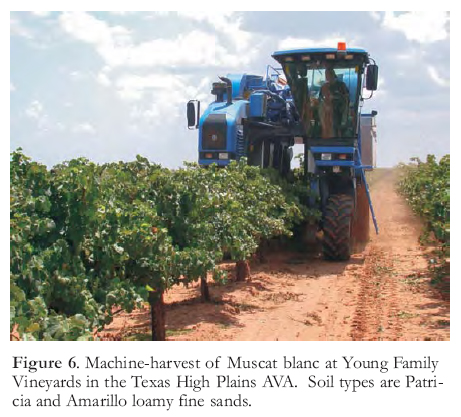 Display large image of Figure 6
Display large image of Figure 6 Display large image of Figure 7
Display large image of Figure 7Climate
26 The Escondido Valley AVA is the warmest and second-driest growing region among west Texas AVAs. Air temperature, GDD, and precipitation variability are associated with elevation (Fig. 8a to d). Annual precipitation (Table 1) ranges from 34.1 to 38.5 cm, with greater precipitation occurring at higher elevations along the southern border (Fig. 8b). Cumulative GDD is very high, ranging from 2768 at the higher elevations to 3035 at the lowest elevations in the north (Fig. 8c), and average about 2970 at Mesa Vineyards, somewhat warmer than Bakersfield, California (2822 GDD; Winkler et al. 1974). However, grapes ripen in July and August in the Escondido Valley AVA, suggesting that comparisons with standard full-season (April to October) degree-day accumulations may not be appropriate. Grape RPMT averages 27.6°C in July and 27.1°C in August (Table 1). Winter temperatures are the mildest among west Texas AVAs; January minimum temperature averages about -0.6°C (Table 1). Spring frost frequency averages about 3.8 days in March and 0.6 days in April at the intermediate elevations where vineyards are planted.
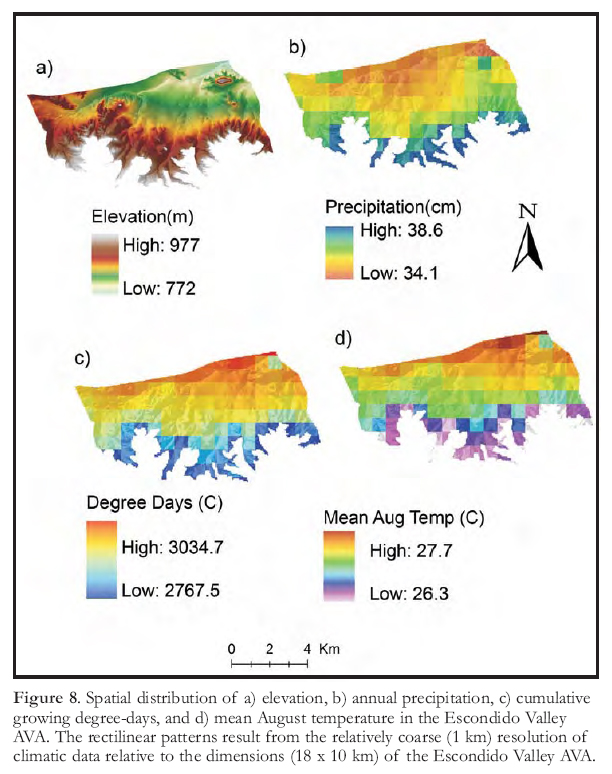 Display large image of Figure 8
Display large image of Figure 8Geology
27 The Escondido Valley AVA lies within a transition zone between the southern extent of Quaternary, alluvial eolian sand, silt, clay, gravel and carbonate deposits common to the High Plains, and the western extent of the Cretaceous Edwards Limestone (Fig. 9a). Quaternary deposits account for almost 40% of the total area and predominate in the central part of the region, whereas Edwards Limestone underlies a slightly larger proportion (43.6%), associated with higher elevations mainly along the southern and eastern boundaries and with a mesa in the northeast corner. A prominent east–west band of Quaternary–Tertiary alluvial deposits of gravel and conglomerate fill the lowest elevations (772 to 790 m) along the northern boundary of the AVA, corresponding to the bed of present day Tunas Creek. North of this band, there are three occurrences of Cretaceous deposits (limestone, mudstone, dolomite, and chert) of the Fredericksburg Group (Fig. 9a).
Soils
28 Three soil associations, all of which are calcareous and alkaline (pH 8.1 to 8.2), characterize the Escondido Valley AVA (Table 5): Ector–Rock outcrop–Dev, Reagan–Hodgins–Iraan, and Lozier–Rock outcrop–Upton. The most suitable vineyard soils are found within the Reagan–Hodgins–Iraan association, which occupies 38.5% of the AVA, generally overlying the Quaternary and Tertiary deposits in the north and central areas (Fig. 9a, b). Mesa Vineyards is located within this soil association, somewhat northeast of the AVA centroid (Fig. 10). The Reagan–Hodgins–Iraan association comprises very deep (>152 cm) soils having silty clay loam texture from 0 to 20 cm, and loam texture beneath. Permeability is moderately high throughout, ranging from 2.56 to 2.68 cm/hr. Available water capacity is good and increases with depth as the proportion of clay increases, from 14 cm within the top 100 cm to 26 cm at depth (Table 5). Soil pH is high (8.1), requiring vineyard management practices to avoid iron and zinc deficiency in grapevines.
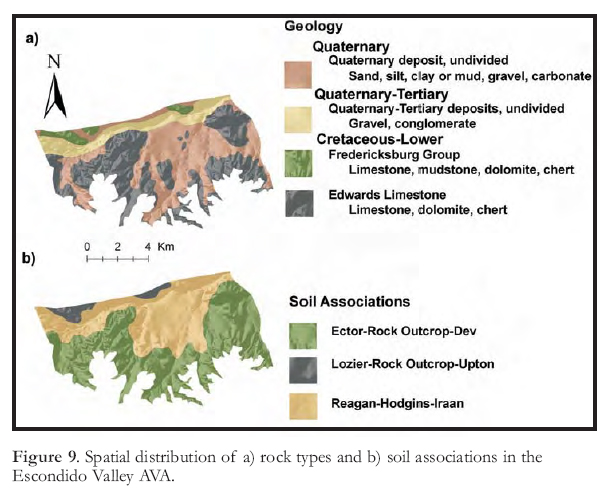 Display large image of Figure 9
Display large image of Figure 9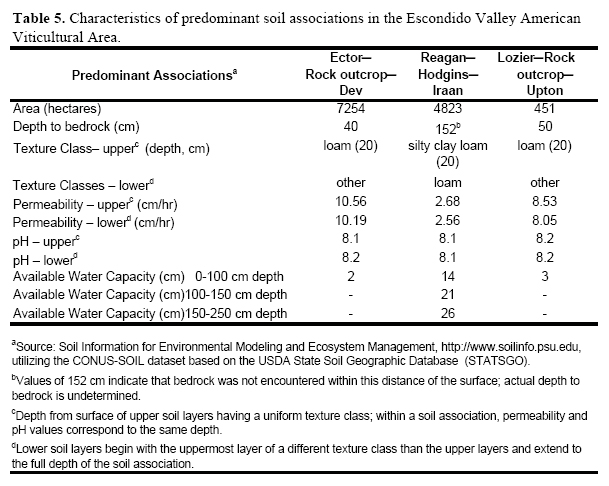 Display large image of Table 5
Display large image of Table 529 The Ector–Rock outcrop–Dev soil association predominates, underlying 58% of the total area, and is generally associated with Edwards Limestone geology and the higher elevations of the southern and eastern portions of the AVA (Fig. 9b). Because this association is mostly shallow gravely loam and rock outcrop, it has inadequate depth for grape production and very low available water capacity, and is therefore not suitable for grape growing. A small area (3.5%) along the northern border of the AVA contains the Lozier–Rock outcrop–Upton soil association (Fig. 9b); these soils are developed on Fredericksburg Group substrate, and have characteristics very similar to the Ector–Rock outcrop–Dev soil association. The soils are gravely loams too shallow for grape production, and have low available water capacity.
Grape and Wine Production
30 As noted above, Ste. Genevieve is Texas’ largest wine producer (58 000 hL annually) and is located, along with the 288 ha Mesa Vineyards, within the Escondido Valley AVA (Figs. 7 and 10). Unlike other Texas wineries, Ste. Genevieve has no tasting room and wine is sold only through distribution to retailers, almost all within Texas. The winery began operation in 1987, producing Cabernet Sauvignon, Merlot, Zinfandel, and other red wines, but has been more recognized for Sauvignon blanc, Chenin blanc, and Chardonnay. The hot, dry climate seems particularly favourable for these white wine cultivars. With the abundant sunlight and high temperatures in this AVA, fruit readily attains high sugar content. The long growing season begins in March, earlier in Escon-dido than the other west Texas AVAs, and presents a risk of frost injury to grapevines after budburst. High GDD leads to early ripening, and harvest occurs in July and August.
Texas Davis Mountains
31 About 150 km west of the Escondido Valley AVA (Fig. 1), the Davis Mountains rise abruptly from the rocky plains of the Chihuahua Desert within the Basin and Range physiographic province of far west Texas. The higher elevation of the Davis Mountains creates a unique environment by forcing westerly winds to rise and cool, condensing moisture and causing increased rainfall compared to the surrounding desert. The Texas Davis Mountains AVA was established in 1998 to acknowledge the distinctive features of this AVA, the highest-elevation wine growing region in Texas. The boundaries of this AVA encompass much of this isolated mountain range, but vineyards are located at lower elevations (1500 to 1600 m) along the southeastern border where favourable soils and irrigation water are available. The predominant grape varieties grown in this region are Cabernet Sauvignon, Sauvignon blanc, Merlot, and Chenin blanc.
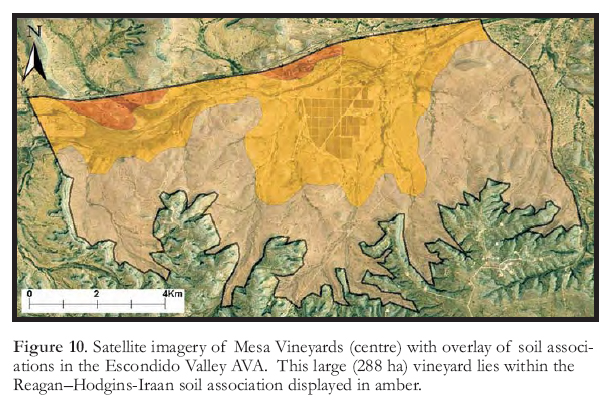 Display large image of Figure 10
Display large image of Figure 10Climate
32 The varied elevation (1125 to 2546 m; Fig. 11a) and topography of the Texas Davis Mountains creates the broadest range of climatic variables of all AVAs in west Texas (Table 1). Precipitation is greatest at the highest elevations, which receive almost 50 cm annually (Fig. 11b); vineyards are at elevations of 1500 to 1600 m, and average 42 to 43 cm annual precipitation. Higher elevations experience only 1430 GDD compared to 2672 at low elevation (Fig. 11c). Favourable vineyard locations in the southeast have approximately 2190 GDD, comparable to the west central area of the Texas High Plains AVA and Lodi, California (Table 2). Temperatures during fruit ripening are the lowest among Texas AVAs, and exhibit a similarly broad range associated with elevation (Fig. 11d); RPMT ranges from 18.8 to 25.6°C in August and 16.7 to 22.6°C in September. Risk of mid-winter freeze injury to grapevines is low, as January minimum temperatures average about -2°C at vineyard locations. The number of frost days is also associated with elevation, ranging from 1.2 to 7.2 days in April. Vineyards are at elevations that experience frost on average about 2.4 days in April, but strategic location of vineyard sites on slopes can mitigate the risk of frost injury.
Geology
33 The Davis Mountains were formed by volcanic activity approximately 37 million years ago (Swanson 1995). Mount Livermore is the highest peak at 2555 m. The geology of the Texas Davis Mountains AVA is dominated by a large area of older volcanic rocks (rhyolite, trachyte, lava flows) at lower elevations in the north and east, and younger volcanic rocks (trachyte, rhyolite, tuff, latite) at the higher elevations in the central and southwest areas, including Mount Livermore, Black Mountain and surrounding peaks (Fig. 12a). Quaternary alluvium (sand, silt, clay, gravel) and alluvial fan deposits occur along the southern border, Quaternary–Tertiary gravel and conglomerate in the northeast corner, and scattered areas of Oligocene intrusive rocks (basalt, trachyte, felsic volcanic rock, rhyolite, phonolite) are located in the west (Fig. 12a).
Soils
34 The relatively recent volcanic activity in this AVA results in a predominance of rock outcrop, and only a limited area of soils suitable for vineyards. The two most prevalent soil associations, Rock outcrop–Mainstay–Liv and Brewster–Rock outcrop–Liv mostly comprise non-soil surface bedrock, and together constitute 82.5% of the total area (Table 6). Both of these associations, as well as the Puerta–Madrone– Rock outcrop association, are considered too shallow (44 to 58 cm to bedrock) for grape production.
 Display large image of Figure 11
Display large image of Figure 11 Display large image of Figure 12
Display large image of Figure 1235 The Musquiz–Boracho–Santo Tomas soil association is the most favourable in the AVA for grape production. It underlies 9% of the area, primarily along the southern boundary where vineyards have been established, and to a lesser extent along the northwestern boundary (Fig. 12b). Soils in this association are deep (up to 144 cm), with loam texture in the upper 20 cm, and clay and clay loam at lower depths. Permeability is high (4.12 cm/hr) in the upper 20 cm, but only moderately high (3.07 cm/hr) at depth as clay content increases. Soil pH is favourable at 7.5 and available water capacity is good: 12 cm within the top 100 cm and 18 cm from 100 to 150 cm depth.
36 The Phantom–Rockhouse–Hodgins soil association accounts for only 1% of the area and is located in the northeast corner at the lowest elevation (1124 to 1300 m) in the AVA. It has a clay loam to loam texture with only moderately high permeability (2.84 cm/hr) in the upper 20 cm, and clay loam below having high permeability (6.25 cm/hr) to a total depth of 142 cm. The pH is favourable and slightly higher than Musquiz–Boracho–Santo Tomas, at 7.6 to 7.8. Available water capacity is similarly favourable at 13 cm within the top 100 cm and 20 cm from 100 to 150 cm depth.
Grape and Wine Production
37 The limited area suitable for vineyards in the Texas Davis Mountains AVA has restricted winery development in the region. Grapes were first planted in 1977 at Blue Mountain Vineyard near Fort Davis; the winery operated from 1995 to 2006, producing award-winning wines from estate-grown Cabernet Sauvignon and Merlot that were notable for good colour and tannins. Although there are no operational wineries in the region today, a vineyard that cultivates Cabernet Sauvignon and Sauvignon blanc provides grapes to Pleasant Hill Winery in Brenham, Texas for appellation-labelled wines.
38 The high-altitude combination of GDD and relatively cool RPMT of the Texas Davis Mountains AVA has been demonstrated to be favourable for traditional Bordeaux grape cultivars. Experimentation with warm-climate grape cultivars, as has been done in the Texas High Plains AVA, has not been conducted in the region, but results at the latter AVA suggest similar opportunities for the Texas Davis Mountains AVA. Low precipitation reduces the risk of fungal diseases, but restricts grape production to areas with irrigation wells. Suitable soils in the Musquiz–Boracho–Santo Tomas association generally correlate with availability of irrigation water, practically limiting grape production to the southern border of the AVA. Although suitable vineyard locations are limited, there is potential for additional vineyard and winery development to take advantage of the unique environmental conditions of this region.
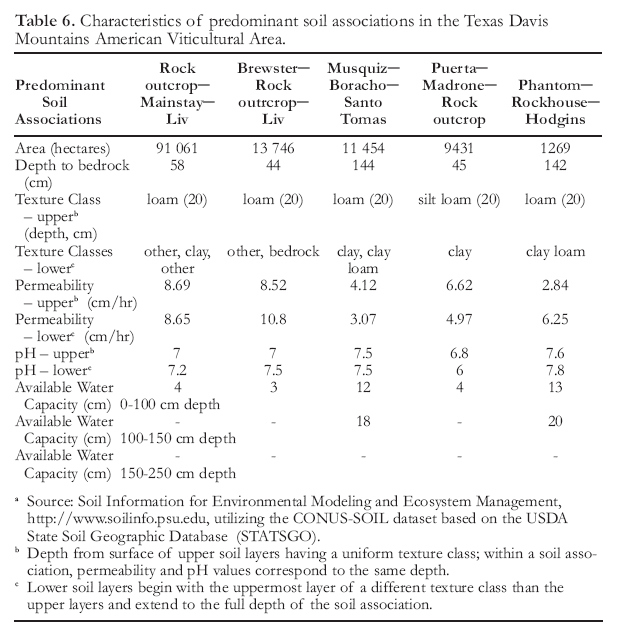 Display large image of Table 6
Display large image of Table 6Mesilla Valley
39 The Mesilla Valley AVA spans two states, Texas and New Mexico, beginning approximately 23 km north of Las Cruces, New Mexico and extending south along the Rio Grande to El Paso, Texas (Fig. 1). The Mesilla Valley is a fertile tableland rising above the floodplain of the Rio Grande and is an important irrigated agricultural region within the Chihuahua Desert in the Basin and Range physiographic province. This AVA was established in 1985 to recognize modern wine grape production within the valley, which is the location of some of the earliest successful grape growing in the United States. The appellation generally corresponds to the area of its namesake valley, trending approximately north–south for 85 km and about 13 km east–west; the east and west boundaries are generally defined by the 1250 or 1280 m elevation contour lines, but elevations are as high as 1300 m in the southeast. The land slopes down from the eastern and western boundaries to the Rio Grande, approximately in the centre of the valley, at an elevation of about 1150 m.
40 The total area of the multi-state AVA is 87 340 ha; the Texas portion is about 19% (16 247 ha) of this total, and occupies the southeastern part of the entire AVA, north and west of El Paso. It is the westernmost AVA in Texas, approximately 280 km northwest of the Texas Davis Mountains. The predominant grape varieties in the full AVA are Viognier, Zinfandel, Muscat blanc, and Sangiovese. The GIS descriptive analysis focuses only on the Texas portion of the Mesilla Valley AVA, although conditions are similar in the remaining area.
Climate
41 The Mesilla Valley AVA is by far the driest in west Texas, with annual precipitation ranging from 20.4 to 29.3 cm (Table 1). Rainfall and other climatic parameters are closely associated with elevation (Fig. 13a); precipitation is least at the lowest elevations in the west and increases with elevation toward the Franklin Mountains in the east (Fig. 13b). The GDD ranges from 2480 to 2849 (Fig. 13c) and averages about 2830 in vineyard areas, somewhat lower than Escondido Valley and similar to Bakersfield, California (2822 GDD; Winkler et al. 1974). As in the Escondido Valley, mild winters and a warm growing season lead to early budburst and fruit ripening in July and August. RPMT is highest in the lower elevation western part of the region (Fig. 13d), ranging from 26.7 to 28.1°C in July and 25.5 to 26.8°C in August. January minimum temperatures present little risk of freeze injury to grapevines, averaging about -1.9°C for the AVA. Spring frost days increase with elevation, ranging from 4.1 to 6.0 days in March, and 0.7 to 1.1 days in April.
Geology
42 The major geological feature of the region is the Rio Grande rift, which results from a period of crustal extension that began between 32 and 27 million years ago, and is today distinguished by faults and volcanoes and associated mountains and basins (Chapin 1979). The ancestral Rio Grande developed about 4 million years ago, following the course of the pre-established north-trending rift valley that extends from Colorado to Mexico. The rift valley today consists of a series of basins deeply filled with sediments from the nearby eroding mountains. Beginning about 780 000 years ago, the ancestral Rio Grande began to erode through its own alluvial plain, and episodes of down-cutting alternated with sediment deposition (Mack 1997). The river now occupies an entrenched valley about 100 m lower than the surrounding, older sedimentary rocks.
43 The Texas portion of the Mesilla Valley AVA is mostly underlain by Quaternary alluvium (sand, silt, clay and gravel) at lower elevations close to the river in the west, and by older Quaternary alluvial deposits (gravel, sand, silt) to the east as elevation climbs toward the Franklin Mountains (Fig. 14a). Deposits of Quaternary–Tertiary clay, silt, sandstone, and conglomerate occur locally at higher elevations, where they underlie the older Quaternary alluvium. Some Quaternary sand sheet deposits are seen along the transition zone between younger and older alluvium, where elevation begins to climb (Fig. 14a).
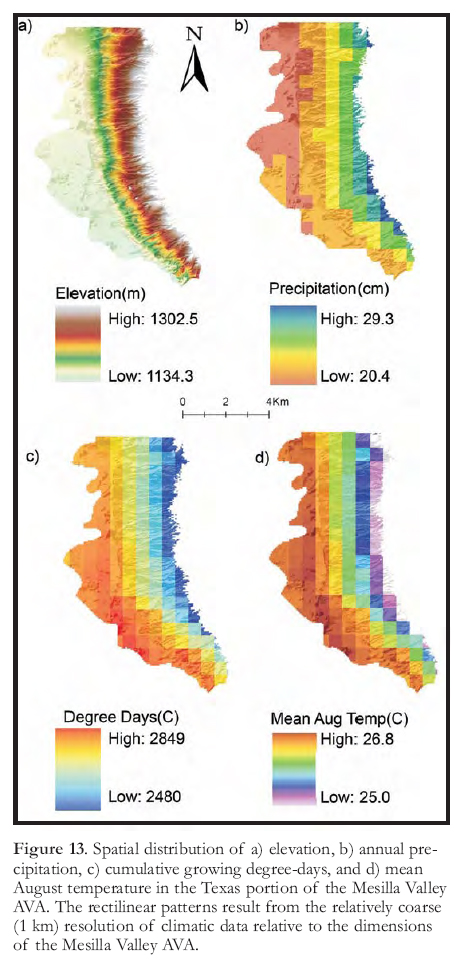 Display large image of Figure 13
Display large image of Figure 13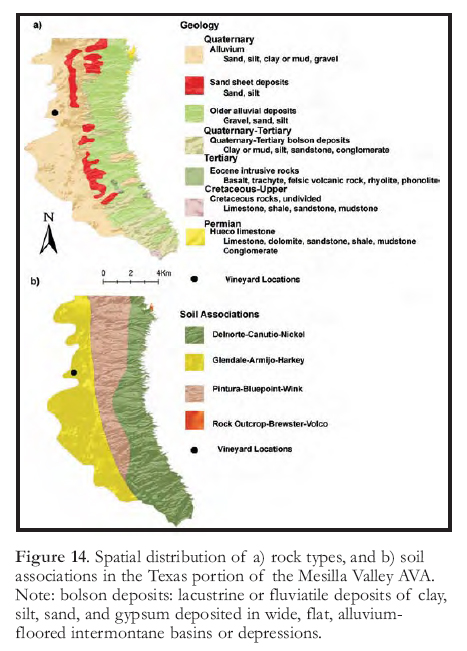 Display large image of Figure 14
Display large image of Figure 14Soils
44 The spatial distribution of the three predominant soil associations in the Mesilla Valley parallels the local geology (Fig. 14b). The Glendale–Armijo–Harkey and Pintura–Blue-point– Wink associations correspond to areas underlain with younger alluvium at lower elevation close to the Rio Grande; Delnorte– Canutio–Nickel is found at higher elevations, generally corresponding to the area of underlying olderalluvium.
45 Vineyards have been primarily located within the area of the Glendale–Armijo–Harkey association, which comprise deep alluvial soils of clay loam texture in the top 30 cm, and sandy loam beneath (Table 7). These soils have a combination of drainage and water holding capacity that is well-suited to grape production. Permeability is high: 5.68 cm/hr in the upper 30 cm, and 9.09 cm/hr at lower depths. Available water capacity is 13 cm in the upper 100 cm and 37 cm in the lower 150 cm. The Pintura–Bluepoint–Wink association has higher permeability and somewhat lower available water capacity, but is similarly favourable for grape production. These alluvial soils are also deep, but have a shallow (10 cm) upper layer of sand, underlain by sandy loam and more sand below. The pH of both these soil series is somewhat high for grape production, ranging from 7.9 to 8.1, which may necessitate management practices to avoid iron and zinc deficiency problems.
46 The Delnorte–Canutio–Nickel soil series comprises deep sandy loam soils with high permeability (15.6 cm/hr) and low available water capacity (Table 7). The generally dry nature of these soils can be difficult to manage for grapes, requiring frequent irrigation and careful monitoring of soil and vine water status.
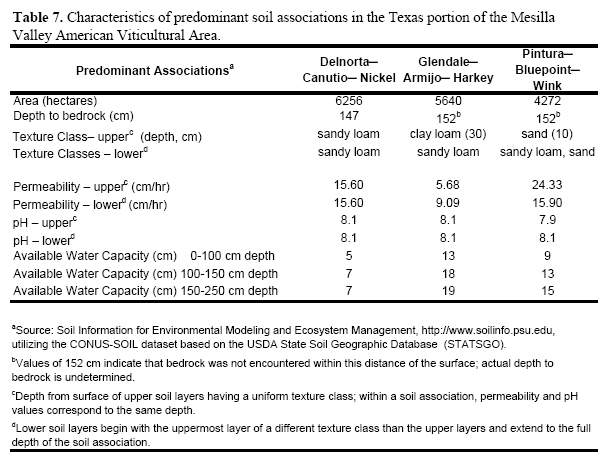 Display large image of Table 7
Display large image of Table 7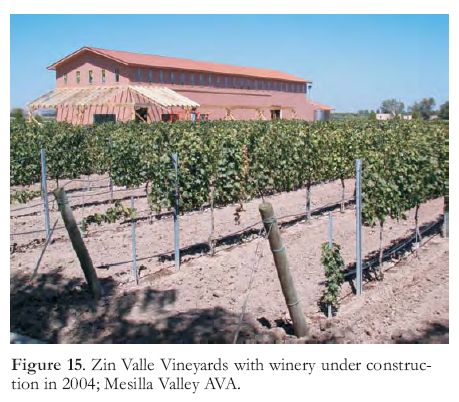 Display large image of Figure 15
Display large image of Figure 15Grape and Wine Production
47 The Texas portion of the Mesilla Valley AVA has seen less vineyard and winery development than within this AVA in New Mexico. There are currently two small wineries in this AVA in Texas, one with an estate vineyard (Zin Valle Vineyards; Fig. 15) producing Zinfandel and Malvasia Bianca. The potential for development of new vineyards is highest in the western part of the AVA, at lower elevations closer to the Rio Grande; these areas have the most favourable combination of good soils and availability of irrigation water. This area also features the lowest precipitation, highest GDD, and highest RPMT. These factors result in good fruit ripening conditions leading to high sugar accumulation, and low disease pressure from fungal pathogens.
SUMMARY AND CONCLUSIONS
48 This research, utilizing the spatial analysis of climate, topography, geology, and soil, establishes a baseline description of wine-grape growing conditions within the four American Viticultural Areas of west Texas. The four AVAs share several common characteristics: high elevation (770 to 1600 m), very warm to hot growing seasons (>2000 GDD), mild winter (January average minimum -0.4 to -0.6°C), and low annual precipitation (20 to 64 cm).
49 High elevation combined with little cloud cover produces high sunlight intensity that contributes to fruitfulness of vines and good colour and tannin development in fruit. Cumulative GDD in the coolest parts of the Texas High Plains AVA (2028) and the Texas Davis Mountains AVA (2190) are comparable to the California wine-growing regions of the Sierra Foothills and Lodi, respectively. It is noteworthy that wine grapes typically mature and are harvested in late August to early September in these west Texas AVAs, by which time degree-day accumulations are as much as 400 fewer than standard full-season (April to October) calculations used in comparisons to other winegrowing regions of the world. The Mesilla Valley and Escon-dido Valley AVAs are warmer still, having 2830 and 2980 GDD, respectively. These AVAs would be classified as ‘too hot’ for wine production by Jones et al. (2010), but this conclusion is contradicted by more than 20 years of successful wine production in the Escon-dido Valley AVA. Again, early grape maturity and harvest (July and August) in the Mesilla Valley and Escondido Valley AVAs may preclude meaningful comparisons of full-season degree-days with other winegrowing regions.
50 The dry growing conditions throughout west Texas are advantageous for grape production because they are not conducive to spread of most fungal diseases of grapevines. Relatively low annual precipitation also enables irrigation practices to be used to manage grapevine vigor and potentially influence grape quality. Winter temperatures are generally mild, making possible the production of Vitis vinifera wine grapes with little risk of freeze injury. Recent vineyard plantings have focused on growing grape cultivars with known adaptation to warm and hot climates, including Sangiovese, Vermentino and Tempranillo, and the Rhone cultivars Viognier, Grenache, Mourvèdre, and Syrah.
51 Soils are highly variable among west Texas AVAs. Vineyards are predominantly planted on loamy fine sands and fine sandy loams in the Texas High Plains AVA, whereas loams and clay loams predominate in the other AVAs. The Texas High Plains AVA leads the state in vineyard hectares and grape production, with more than 440 ha and continued growth underway. It also has the most potential for expansion, as more than 1.25 million ha of deep, well-drained loamy fine sands, sandy loams, and loam soils are well-suited for grape production.
52 The combination of favourable climatic conditions, planting of climate-appropriate grape cultivars, and good vineyard soils has helped establish west Texas as a significant new winegrowing region with demonstrated capability of producing high quality wines and great potential for significant expansion.
The authors thank Andrew Birt and Hyunsook Kim of the Knowledge Engineering Laboratory at Texas A&M University for contributions to this research and development of the ArcIMS application. We gratefully acknowledge the critical review of this manuscript and many helpful suggestions by R.W. Macqueen and L.D. Meinert.